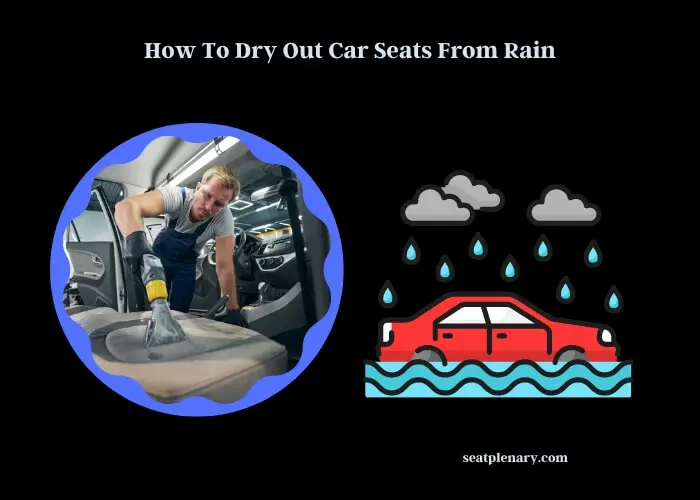To dry out car seats from rain, you can simply place them in a sunny spot or in a well-ventilated room equipped with a couple of fans. Although these drying methods may require a bit of time, they usually provide satisfactory results.
Let’s focus on some of the other beneficial methods that can be utilized in this scenario. Ventilation is crucial in accelerating the drying process. Natural airflow can effectively evaporate moisture, reducing the dampness in your car seats.
Absorbents, like silica gel or rice, are another effective solution. These substances can soak up any remaining moisture, mitigating the chance of mildew or mold growth.
Heaters can also be used to dry out your car seats, though one should be careful to avoid overheating or damaging the upholstery. The warm air generated can evaporate the moisture quickly, ensuring the seats dry out faster.
Next, we have the traditional method of using towels. This involves blotting the damp areas on the seat to absorb as much water as possible. Pair this method with other techniques to speed up the process.
You can also utilize a vacuum, preferably a wet/dry vacuum, to suck up the moisture from your seats. This can be especially handy if the water has soaked deep into the cushioning.
Consider using dehumidifiers if the dampness persists. These devices can lower the moisture levels in the car, aiding in faster drying.
Upholstery cleaners can assist in this process as well. These specially designed products not only clean but also help to dry the seats, leaving them fresh and odor-free.
Lastly, remember that time is an essential factor in drying out car seats from rain. It is crucial not to rush the process, as doing so may lead to incomplete drying and potential damage to your seats.
A Practical Guide: Drying Out Car Seats After Rain

Immediate Measures to Extract Excess Water
Wiping with Absorbent Cloth: Speed and Efficiency
The moment you notice your car seats are wet, immediate action can help mitigate damage. Grab an absorbent towel or cloth to blot out as much water as you can from the seats. Remember to apply pressure to soak up water, but avoid rubbing, which can damage the fabric.
Wet/Dry Vacuum: Tool for Maximum Extraction
A wet/dry vacuum is an excellent tool for extracting water from your car seats. Use it to suck up as much water as possible, reaching into the crevices and edges of the seat for comprehensive moisture removal.
Harnessing the Sun and Air
Positioning for Optimal Sun Exposure
Nature can be an effective ally in your quest to dry out your car seats. If possible, park your car in an area with plenty of sunlight, leaving the windows slightly open to allow air circulation and enhance the drying process.
Enhancing Ventilation: Fans and Car’s Own System
Circulating air can help to dry out car seats. Use fans directed at the wet areas, or even use your car’s own air conditioning or heating system. Be sure to keep the car doors open for better air circulation.
Pros and Cons of Different Drying Techniques
| Drying Technique | Pros | Cons |
| Natural Sunlight | Free and effective | Requires good weather, can take a long time |
| Air Circulation | Speeds up the drying process | Requires equipment, such as fans |
| Heat Application | Can dry seats quickly | Risk of damaging the car seats if not careful |
| Dehumidifiers | Effective in high-humidity environments | Can be costly and requires electricity |
Effective Use of Heat for Drying
Choosing the Right Tools: Hairdryers and Heaters
Applying heat can speed up the drying process. Using a hairdryer or a portable heater can be an effective way to dry your car seats. Aim these devices towards the wet areas, making sure to keep them at a safe distance to prevent heat damage.

Measures to Avoid Heat Damage
While heat can be helpful, it can also damage your car seats if not used correctly. Avoid placing heat sources too close to the seats, and keep the temperature moderate. Never leave a heat source unattended in your vehicle.
Dehumidifiers and Desiccants: Special Tools Against Moisture
Dehumidifiers: Speeding Up the Process
A dehumidifier can be extremely helpful in speeding up the drying process, especially in humid conditions. The device works by extracting moisture from the air, thereby creating an environment conducive to quick drying.
Commercial Desiccants and DIY Alternatives: Rice and Baking Soda
Desiccants are substances that absorb moisture. Commercial desiccants can be effective, but in a pinch, you can use rice or baking soda. Sprinkle these on the wet areas, let them sit for several hours to absorb the moisture, then vacuum them up.
Comparing Commercial Desiccants and DIY Alternatives
| Desiccant Type | Efficacy | Cost | Accessibility |
| Commercial Desiccants | High | Can be expensive | Available at most home stores |
| DIY Alternatives: Rice, Baking Soda | Moderate | Low | Easily found in most households |
Post-Drying Cleaning Measures
Reasons to Clean the Seat After Drying
Even after your seats have dried, it’s a good idea to clean them. Cleaning can remove any potential residue left by the drying process and can help eliminate odors that may have developed.
Selecting Appropriate Cleaning Products
Choosing the right cleaning product for your car seats is crucial. Ensure the product is safe for the material of your car seats. It’s also advisable to opt for a product that includes a mildewcide to prevent the growth of mold and mildew.
Evaluating Various Cleaning Products
| Cleaning Product | Effectiveness | Price | Environmental Impact |
| Commercial Upholstery Cleaners | High | Varies by brand | Varies by brand |
| DIY Alternatives: Vinegar/Water Mix | Moderate | Low | Environmentally friendly |
| Professional Cleaning Services | High | Can be expensive | Varies by service |
Proactive Steps to Shield Your Car’s Interior
Waterproof Seat Covers: Extra Layer of Protection
A practical way to prevent water damage to your car seats in the future is to invest in waterproof seat covers. They provide an additional layer of protection against rain and spills, and can be easily removed and dried if they get wet.
Quality Window Seals: Investment for Long-Term Solutions
Quality window seals are a worthwhile investment to protect against rain. These seals can prevent water from entering your car during heavy rain or when parked in rainy conditions, ensuring your seats stay dry.
Handling Persistent Dampness and Odor
Seeking Professional Assistance
If dampness and odor persist after your best efforts to dry and clean your seats, it may be time to seek professional help. Car cleaning professionals have the tools and knowledge to effectively deal with stubborn moisture and odors.
Dealing with Mold and Mildew
Mold and mildew can develop if seats are not dried effectively, posing a risk to your health and causing unpleasant odors. Professional cleaning services can help eradicate mold and mildew and prevent their recurrence.
Frequently Asked Questions (FAQs)
What Can I Do If I Forgot to Close the Sunroof and My Car Got Wet?
After removing any visible pools of water, start drying out your car by blotting with an absorbent towel and using a wet/dry vacuum. Then, take advantage of sunlight and air circulation to help with the drying process.
Can I Clean Wet Carpet in My Car Myself?
Yes, you can clean a wet carpet in your car yourself. Use a wet/dry vacuum to remove as much water as possible. Then, use baking soda or commercial desiccants to absorb remaining moisture. Afterward, use an appropriate carpet cleaning solution.
How Can I Prevent My Car Seats from Getting Soaked in the Rain?
To prevent moisture on chair during rainy weather, consider using waterproof seat covers or park your car in a covered area. Placing a towel or blanket on the seats can also help absorb any excess water. Regularly checking for and repairing any leaks in the car can also prevent moisture buildup.
Why Does My Car Seat Still Smell After Getting Rained On and Drying Out?
The smell could be due to mold or mildew, which can occur if the seat didn’t dry thoroughly. It might be necessary to clean the seat with a mildewcide-infused product or seek professional cleaning services to eliminate odors and potential health hazards.
How Can I Dry Cloth Seats in a Car After They’ve Gotten Wet?
After blotting and vacuuming up as much water as possible, you can dry cloth car seats by positioning the car for optimal sun exposure and using fans for air circulation. A dehumidifier can also speed up the drying process.
How Can I Dry Out a Flooded Car Floor?
Remove any excess water using a wet/dry vacuum, then use towels, a hairdryer, or a heater to help speed up the drying process. Commercial desiccants or home alternatives like rice and baking soda can absorb remaining moisture.
What Can I Do to Dry Wet Seats in a Car Quickly?
To dry wet seats quickly, extract as much water as possible using an absorbent towel and a wet/dry vacuum. Then, use a combination of heat, air circulation, and a dehumidifier or desiccants to speed up the drying process.
How Can I Dry My Car Seats After Rain?
Start by blotting the seats with an absorbent towel to remove excess water, then use a wet/dry vacuum for a more thorough extraction. Position your car for maximum sun exposure and use fans or your car’s air system to promote air circulation. Using a heater or a hairdryer can speed up the process, and a dehumidifier or desiccants can be helpful, especially in humid conditions.
Navigating how to dry out car seats from rain doesn’t have to be daunting. With the right tools and knowledge, you can quickly take action to protect your car’s interior and maintain a dry, comfortable environment for your travels.
Relevant Resources:
